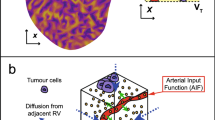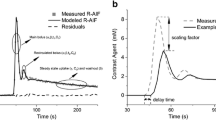Abstract
Object
Dynamic contrast enhanced MRI and pharmacokinetic modelling provide a powerful tool for tumour diagnosis and treatment evaluation. However, several studies show low reproducibility of the technique and poor precision of the transendothelial transfer constant K trans. This work proposes a theoretical framework describing how finite signal-noise-ratio (SNR) in the MR images is propagated throughout the measurement protocol to uncertainty on the kinetic parameter estimates.
Materials and methods
After deriving a distribution for the contrast agent concentration, a maximum likelihood estimator (MLM) is proposed that exhibits Cramer–Rao lower bounds (CRLB). An analytical expression is derived for the CRLB that can be used to determine confidence intervals for kinetic parameters and to investigate the influence of protocol parameters as scan time and temporal resolution on K trans-precision.
Results
Ktrans-uncertainty can be reduced up to 30% by using MLM in comparison with least square estimator. Ktrans-precision is proportional to the SNR and depends strongly on the kinetic parameter values themselves. Minimal scan time and temporal resolution were found to be 15 min and 15 s, respectively, for Gd-DTPA. Temporal resolution should be enhanced by decreasing the NEX parameter (NEX ≤ 1).
Conclusion
CRLB provide a golden standard to construct 95% confidence intervals, which can be used to perform protocol optimization and to test the statistical significance of K trans-changes in treatment evaluation.
Similar content being viewed by others
References
Aerts HJWL, van Riel NAW, Backes WH (2008) System identification theory in pharmacokinetic modeling of dynamic contrast-enhanced MRI: influence of contrast injection. Magn Reson Med 59(5): 1111–1119
Ah-See MLW, Makris A, Taylor NJ, Harrison M, Richman PI, Burcombe RJ, Stirling JJ, d’Arcy JA, Collins DJ, Pittam MR, Ravichandran D, Padhani AR (2008) Early changes in functional dynamic magnetic resonance imaging predict for pathologic response to neoadjuvant chemotherapy in primary breast cancer. Clin Cancer Res 14(20): 6580–6589
Barrett T, Kobayashi H, Brechbiel M, Choyke PL (2006) Macromolecular MRI contrast agents for imaging tumor angiogenesis. Eur J Radiol 60(3): 353–366
Batchelor Te (2007) AZD2171, a pan-VEGF receptor tyrosine kinase inhibitor, normalizes tumor vasculature and alleviates edema in glioblastoma patients. Cancer Cell 11(1): 83–95
Bernstein M, King K, JZ X (2004) Basic pulse sequences. In: Handbook of MRI pulse sequences, vol 1. Elsevier Academic Press, Amsterdam, p 1017
Bonny JM, Foucat L, Laurent W, Renou JP (1998) Optimization of signal intensity and T1-dependent contrast with nonstandard flip angles in spin-echo and inversion-recovery MR imaging. J Magn Reson 130(1): 51–57
Buckley DL (2002) Uncertainty in the analysis of tracer kinetics using dynamic contrast-enhanced T-1-weighted MRI. Magn Reson Med 47(3): 601–606
Calamante F, Vonken E, van Osch M (2007) Contrast agent concentration measurements affecting quantification of bolus-tracking perfusion MRI. Magn Reson Med 58(3): 544–553
Cavassila S, Deval S, Huegen C, van Ormondt D, Graveron-Demilly D (2001) Cramer-rao bounds: an evaluation tool for quantitation. NMR Biomed 14(4): 278–283
Ceelen W, Smeets P, Backes W, Van Damme N, Boterberg T, Demetter P, Bouckenooghe I, De Visschere M, Peeters M, Pattyn P (2006) Noninvasive monitoring of radiotherapy-induced microvascular changes using dynamic contrast enhanced magnetic resonance imaging (DCE-MRI) in a colorectal tumor model. Int J Radiat Oncol Biol Phys 64(4): 1188–1196
Collins DJ, Padhani AR (2004) Dynamic magnetic resonance imaging of tumor perfusion. IEEE Eng Med Biol 23(5): 65–83
De Deene Y, Van de Walle R, Achten E, De Wagter C (1998) Mathematical analysis and experimental investigation of noise in quantitative magnetic resonance imaging applied in polymer gel dosimetry. Signal Process 70(2): 85–101
Di Giovanni P, Azlan C, Ahearn TS, Semple SI, Gilbert FJ, Redpath TW (2010) The accuracy of pharmacokinetic parameter measurement in DCE-MRI of the breast at 3T. Phys Med Biol 55(1): 32–121
Furman-Haran E, Schechtman E, Kelcz F, Kirshenbaum K, Degani H (2005) Magnetic resonance imaging reveals functional diversity of the vasculature in benign and malignant breast lesions. Cancer-Am Cancer Soc 104(4): 708–718
Galbraith SM, Lodge MA, Taylor NJ, Rustin GJS, Bentzen S, Stirling JJ, Padhani AR (2002) Reproducibility of dynamic contrast-enhanced MRI in human muscle and tumours: comparison of quantitative and semi-quantitative analysis. NMR Biomed 15(2): 132–142
Goh V, Padhani AR, Rasheed S (2007) Functional imaging of colorectal cancer angiogenesis. Lancet Oncol 8(3): 245–255
Gudbjartsson H, Patz S (1995) The rician distribution of noisy MRI data. Magn Reson Med 34(2): 910–914
Heilmann M, Kiessling F, Enderlin M, Schad LR (2006) Determination of pharmacokinetic parameters in DCE MRI—consequence of nonlinearity between contrast agent concentration and signal intensity. Invest Radiol 41(6): 536–543
Henderson E, Rutt BK, Lee TY (1998) Temporal sampling requirements for the tracer kinetics modeling of breast disease. Magn Reson Imaging 16(9): 1057–1073
Heverhagen JT, von Tengg-Kobligk H, Baudendistel KT, Jia G, Polzer H, Henry H, Levine AL, Rosol TJ, Knopp MV (2004) Benign prostate hyperplasia: evaluation of treatment response with DCE MRI. Magn Reson Mater Phy 17(1): 5–11
Kiessling F, Lichy M, Grobholz R, Farhan N, Heilmann M, Michel MS, Trojan L, Werner A, Rabe J, Delorme S, Kauczor HU, Schlemmer HP (2003) Detection of prostate carcinomas with T1-weighted dynamic contrast-enhance MRI value of two-compartment model. Radiologe 43(6): 474–480
Koh TS, Thng CH, Lee PS, Hartono S, Rumpel H, Goh BC, Bisdas S (2008) Hepatic metastases: in vivo assessment of perfusion parameters at dynamic contrast-enhanced MR imaging with dual-input two-compartment tracer kinetics model. Radiology 249(1): 307–320
Lopata RGP, Backes WH, van den Bosch PPJ, van Riel NAW (2007) On the identifiability of pharmacokinetic parameters in dynamic contrast-enhanced imaging. Magn Reson Med 58(2): 425–429
Macovski A (1996) Noise in mri. Magn Reson Med 36(3): 494–497
Ocak I, Bernardo M, Metzger G, Barrett T, Pinto P, Albert PS, Choyke PL (2007) Dynamic contrast-enhanced MRI of prostate cancer at 3 T: a study of pharmacokinetic parameters. Am J Roentgenol 189(4): W192–W201
Padhani AR (2002) Dynamic contrast-enhanced MRI in clinical oncology: Current status and future directions. J Magn Reson Imaging 16(4): 407–422
Padhani AR, Hayes C, Landau S, Leach MO (2002) Reproducibility of quantitative dynamic MRI of normal human tissues. NMR Biomed 15(2): 143–153
Parker GJM, Roberts C, Macdonald A, Buonaccorsi GA, Cheung S, Buckley DL, Jackson A, Watson Y, Davies K, Jayson GC (2006) Experimentally-derived functional form for a population-averaged high-temporal-resolution arterial input function for dynamic contrast-enhanced MRI. Magn Reson Med 56(5): 993–1000
Preibisch C, Deichmann R (2009) Influence of RF spoiling on the stability and accuracy of T-1 mapping based on spoiled FLASH with varying flip angles. Magn Reson Med 61(1): 125–135
Radhakrishna Rao C (1945) Information and the accuracy attainable in the estimation of statistical parameters. Bull Calcutta Math Soc 37: 81–91
Rohrer M, Bauer H, Mintorovitch J, Requardt M, Weinmann HJ (2005) Comparison of magnetic properties of MRI contrast media solutions at different magnetic field strengths. Invest Radiol 40(11): 715–724
Schabel MC, Morrell GR (2009) Uncertainty in T-1 mapping using the variable flip angle method with two flip angles. Phys Med Biol 54(1): N1–N8
Schabel MC, Parker DL (2008) Uncertainty and bias in contrast concentration measurements using spoiled gradient echo pulse sequences. Phys Med Biol 53(9): 2345–2373
Schwenzer NF, Kotter I, Henes JC, Schraml C, Fritz J, Claussen CD, Horger M (2010) The role of dynamic contrast-enhanced MRI in the differential diagnosis of psoriatic and rheumatoid arthritis. Am J Roentgenol 194(3): 715–720
Stephens MA (1979) Tests of fit for the logistic distribution based on the empirical distribution function. Biometrika 66(3): 591–595
Tofts PS (1997) Modeling tracer kinetics in dynamic Gd-DTPA MR imaging. J Magn Reson Imaging 7(1): 91–101
Tofts PS, Brix G, Buckley DL, Evelhoch JL, Henderson E, Knopp M, Larsson HBW, Lee TY, Mayr NA, Parker GJM, Port RE, Taylor J, Weisskoff RM (1999) Estimating kinetic parameters from dynamic contrast-enhanced T-1-weighted MRI of a diffusable tracer: Standardized quantities and symbols. J Magn Reson Imaging 10(3): 223–232
Vincensini D, Dedieu V, Eliat PA, Vincent C, Bailly C, de Certaines J, Joffre F (2007) Magnetic resonance imaging measurements of vascular permeability and extracellular volume fraction of breast tumors by dynamic Gd-DTPA-enhanced relaxometry. Magn Reson Imaging 25(3): 293–302
Yang C, Karczmar GS, Medved M, Oto A, Zamora M, Stadler WM (2009) Reproducibility assessment of a multiple reference tissue method for quantitative dynamic contrast enhanced-MRI analysis. Magn Reson Med 61(4): 851–859
Yankeelov TE, Rooney WD, Li X, Springer CS (2003) Variation of the relaxographic “shutter-speed” for transcytolemmal water exchange affects the CR bolus-tracking curve shape. Magn Reson Med 50(6): 1151–1169
Zwick S, Brix G, Tofts P, Strecker R, Kopp-Schneider A, Laue H, Semmler W, Kiessling F (2010) Simulation-based comparison of two approaches frequently used for dynamic contrast-enhanced mri. Eur Radiol 20(2): 432–442
Author information
Authors and Affiliations
Corresponding author
Rights and permissions
About this article
Cite this article
De Naeyer, D., De Deene, Y., Ceelen, W.P. et al. Precision analysis of kinetic modelling estimates in dynamic contrast enhanced MRI. Magn Reson Mater Phy 24, 51–66 (2011). https://doi.org/10.1007/s10334-010-0235-6
Received:
Revised:
Accepted:
Published:
Issue Date:
DOI: https://doi.org/10.1007/s10334-010-0235-6




